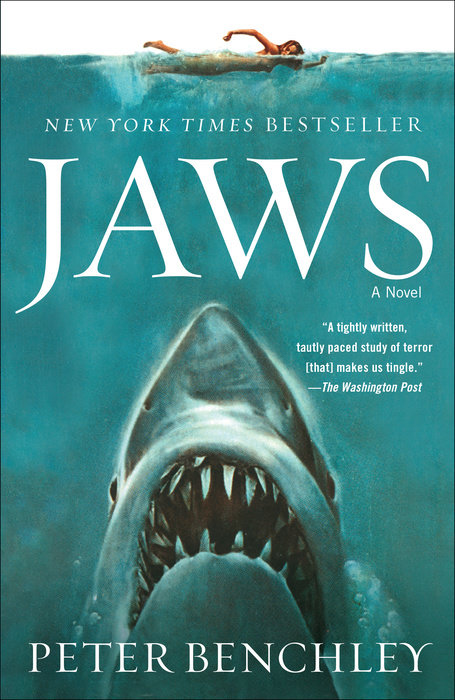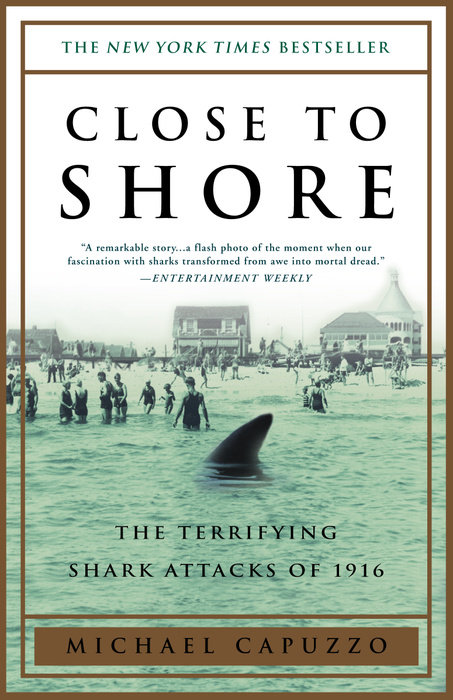Growing up on the Jersey Shore, summer meant three things to me: ice cream, boardwalk rides, and sharks. Sharks and New Jersey always went hand in hand in my mind because of one strange, isolated anomaly of nature: the Jersey Shore shark attacks of early July 1916. A century later, the effects of these attacks, in which five people were bitten—and only one survived—still reverberate not only in New Jersey but throughout the national consciousness.
Michael Capuzzo’s historical account, CLOSE TO SHORE: THE TERRIFYING SHARK ATTACKS OF 1916, is suspenseful and terrifying…simply because it’s true.
Thoroughly researched and deftly told, this is the story that first made the public aware of the dangers that lurked in the ocean. Until 1916, only fishermen and sailors had encountered sharks. But with recent economic growth, ease of travel, and the increasing amount of leisure time available to the population, beach-going became a popular pastime for Americans. Unfortunately, many Americans were unfamiliar with the dangers of the ocean, which, as Capuzzo reminds us, is still a wilderness.
In CLOSE TO SHORE, we follow a mysterious shark up the Jersey coast from Beach Haven all the way to Matawan Creek, fifteen miles inland. The victims are painted clearly and their families’ shock and grief is palpable, as is the panic that spreads across the country—even raising concern in the cabinet of President Woodrow Wilson.
Reading CLOSE TO SHORE is rather like reading a monster story, complete with angry villagers and violent mobs. Yet the shark is presented as so much more than a mindless man-eater; the shark (or possibly sharks) fascinates Capuzzo and compels him to search for a scientific explanation for this rare event. CLOSE TO SHORE is a spellbinding glimpse at a time long gone and a fear that is universal.
Frankly, without the Jersey Shore attacks, it is hard to imagine that Peter Benchley would have written JAWS (though he argued he was not inspired by them); that Steven Spielberg would have made his frightening summer blockbuster; and that Discovery Channel’s Shark Week—now an annual celebration—would have aired at all.
In the novel JAWS, a rogue great white shark swims into a New Jersey beach community. Since its publication in 1974, so much has been learned and written about sharks. Forty-two years later, you might ask: Is the novel still worth reading? Well, yes—if you want to be scared out of the water, and you will be. The opening chapter is one of the most terrifying pieces of writing I’ve ever read.
If you are more familiar with the film, you might be surprised that the novel features many minor subplots, and that the shark meets its demise in a different way. But in the book’s most brilliant narrative choice, many of the chilling attacks are described from the shark’s point of view. It’s a tense read, one that can make even the bravest swimmer nervous around water.
Exactly a century after the New Jersey shark attacks, the beach resort towns where they occurred still fill annually with tourists and locals, though they’ve never quite forgotten what happened to those five ill-fated swimmers. The fact that I was able to attend a showing of JAWS on the very beach where one of the attacks occurred confirms that the memory of the tragedy is still very much alive. And yes, JAWS is a lot scarier when you watch it with the surf crashing behind you, unseen creatures lurking beneath.…
Kerry Fiallo is a New York native and copywriter at Simon & Schuster.









